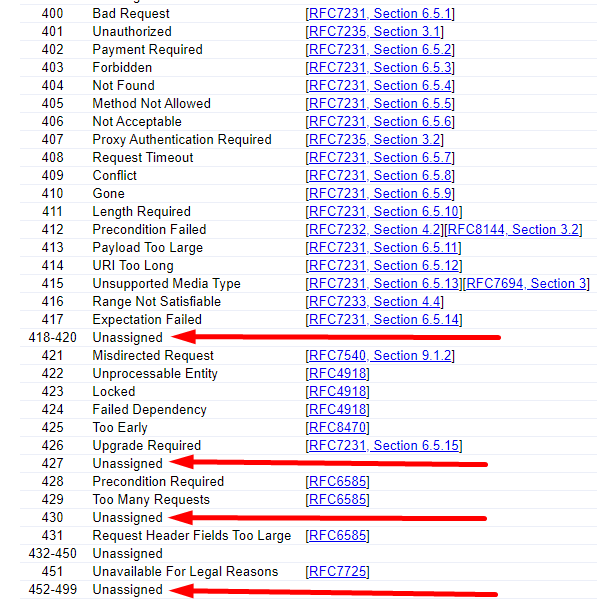Some applications add their custom response codes in the range 600-799. Check for example the response code list from KeyNote here
Keynote Defined Error Codes (600-799)
600: CONNECTION ERROR - This indicates a general connection error
601: INCOMPLETE ERROR - This indicates sever sends an incomplete page/object (as indicated by Content-Length header)
602: UNEXPECTED CLOSE ERROR - This indicates socket connection has been closed unexpectedly
603: REFUSED ERROR - This indicates a request to connect to the server is refused
604: TIMEOUT ERROR - This indicates there is no activity in socket connection in 3 minutes
605: REDIRECT ERROR - This indicates an error in redirect HTTP header
606: SSL ERROR - This indicates a general error in SSL
607: HEADER ERROR - This indicates a malformed HTTP header
608: EMPTY RESPONSE ERROR - This indicates server doesn't send any response after a request is sent
609: UNKNOWN HOST ERROR - This indicates socket receives an unknown host error from DNS
610: NO ROUTE TO HOST ERROR - This indicates a no route to host error was received while attempting to open a socket
611: SOCKET ERROR - This indicates a general socket error
612: FRAME LOOP ERROR - This indicates a page has a frame loop (frame A includes Frame B that includes Frame A)
613: REDIRECT LOOP ERROR - This indicates a page has a redirect loop (page A redirects to page B that redirects to page A)
614: CONNECTION RESET ERROR - This indicates socket receive a reset signal from the server
615: SOCKET PROTOCOL ERROR - This indicates an error in socket protocol
616: SOCKET BIND ERROR - This indicates an error in binding the socket
617: CONNECTION ERROR - This indicates a general socket connection error
618: CHUNK ERROR - This indicates an error in chunked encoding
619: SSL TIMEOUT - This indicates a timeout during SSL handshake (2 minutes)
620: SSL END OF INPUT - This indicates an end-of-file is received during SSL handshake
621: SSL HANDSHAKE ERROR - This indicates a general error during SSL handshake
622: SSL CERTIFICATE ERROR - This indicates an error in SSL certificate verification
623: SSL AUTHENTICATION ERROR - This indicates an authentication error during SSL handshake
624: SSL BAD MAC ERROR - This indicates a bad MAC during SSL handshake
625: SSL CIPHER ERROR - This indicates a cipher error during SSL handshake
701: ERROR TEXT FOUND - This code is returned if any error text (such as, "Service Unavailable") are found in the main page (frame HTML contents included). Note that the error text must be defined in advance of the test. Error text means if the text is found, this session should be considered a failure.
702: REQUIRED TEXT NOT FOUND - This code is returned If not all required texts are found in the main page. Note that required text must be defined in advance of the test. Required text means if the text is not found, this session should be considered a failure.
703: HTML BODY EMPTY - This code is returned if the HTML body of the page is empty (only if error text or required text has been defined).
Whether this is good practice I would not dare to say, but it is an interesting reference at least.

